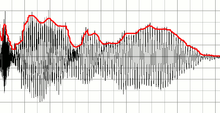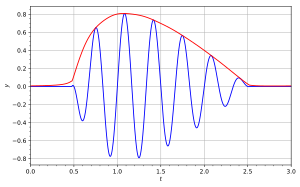| This article needs additional citations for verification. Please help improve this article by adding citations to reliable sources. Unsourced material may be challenged and removed. Find sources: "Envelope detector" – news · newspapers · books · scholar · JSTOR (June 2024) (Learn how and when to remove this message) |

An envelope detector (sometimes called a peak detector) is an electronic circuit that takes a (relatively) high-frequency signal as input and outputs the envelope of the original signal.
Diode detector

 Simple diode detector. An input voltage (the green AM signal) is first rectified by the diode. The output voltage (red) ripples just below the input's upper envelope by charging and discharging the capacitor.
Simple diode detector. An input voltage (the green AM signal) is first rectified by the diode. The output voltage (red) ripples just below the input's upper envelope by charging and discharging the capacitor.
A simple form of envelope detector used in detectors for early radios is the diode detector. Its output approximates a voltage-shifted version of the input's upper envelope.
Between the circuit's input and output is a diode that performs half-wave rectification, allowing substantial current flow only when the input voltage is around a diode drop higher than the output terminal.
The output is connected to a capacitor of value and resistor of value in parallel to ground. The capacitor is charged as the input voltage approaches its positive peaks. At other times, the capacitor is gradually discharged through the resistor. The resistor and capacitor form a 1st-order low pass filter, which attenuates higher frequencies at a rate of -6 dB per octave above its cutoff frequency of . The filter's RC time constant must be small enough to track quickly-falling envelope slopes and "top up" the envelope's voltage every peak to prevent negative peak clipping.
AM demodulation
Envelope detectors can be used to demodulate an amplitude modulated (AM) signal. Such a device is often used to demodulate AM radio signals because the envelope of the modulated signal is equivalent to the baseband signal. To sufficiently attenuate the frequency of the carrier wave frequency , the cutoff frequency of the low-pass filter should be well-below the carrier wave's frequency. To avoid negative peak clipping, the original signal that is modulated is usually limited to a maximum frequency to limit the maximum rate of fall of the AM signal. To minimize distortions from both ripple and negative peak clipping, the following inequality should be observed:
Next, to filter out the DC component, the output could pass through a simple high-pass filter, such as a DC-blocking capacitor.
General considerations
Most practical envelope detectors use either half-wave or full-wave rectification of the signal to convert the AC audio input into a pulsed DC signal. Full-wave rectification traces both positive and negative peaks of the envelope. Half-wave rectification ignores negative peaks, which may be acceptable based on the application, particularly if the input signal is symmetric about the horizontal axis. Low threshold voltage diodes (e.g. germanium or Schottky diodes) may be preferable for tracking very small envelopes.
The filtering for smoothing the final result is rarely perfect and some "ripple" is likely to remain on the output, particularly for low frequency inputs such from a bass instrument. Reducing the filter cutoff frequency gives a smoother output, but designers must compromise this with the circuit's high frequency response.
Definition of the envelope

Any AM or FM signal can be written in the following form
In the case of AM, φ(t) (the phase component of the signal) is constant and can be ignored. In AM, the carrier frequency is also constant. Thus, all the information in the AM signal is in R(t). R(t) is called the envelope of the signal. Hence an AM signal is given by the function
with m(t) representing the original audio frequency message, C the carrier amplitude and R(t) equal to C + m(t). So, if the envelope of the AM signal can be extracted, the original message can be recovered.
In the case of FM, the transmitted has a constant envelope R(t) = R and can be ignored. However, many FM receivers measure the envelope anyway for received signal strength indication.
Precision detector
An envelope detector can also be constructed using a precision rectifier feeding into a low-pass filter.
Drawbacks
The envelope detector has several drawbacks:
- The input to the detector must be band-pass filtered around the desired signal, or else the detector will simultaneously demodulate several signals. The filtering can be done with a tunable filter or, more practically, a superheterodyne receiver
- It is more susceptible to noise than a product detector
- If the signal is overmodulated (i.e. modulation index > 1), distortion will occur
Most of these drawbacks are relatively minor and are usually acceptable tradeoffs for the simplicity and low cost of using an envelope detector.
Audio
See also: Noise gate § Trance gatingAn envelope detector is sometimes referred to as an envelope follower in musical environments. It is still used to detect the amplitude variations of an incoming signal to produce a control signal that resembles those variations. However, in this case the input signal is made up of audible frequencies.
Envelope detectors are often a component of other circuits, such as a compressor or an auto-wah or envelope-followed filter. In these circuits, the envelope follower is part of what is known as the "side chain", a circuit which describes some characteristic of the input, in this case its volume.
Both expanders and compressors use the envelope's output voltage to control the gain of an amplifier. Auto-wah uses the voltage to control the cutoff frequency of a filter. The voltage-controlled filter of an analog synthesizer is a similar circuit.
Modern envelope followers can be implemented:
- directly as electronic hardware,
- or as software using either a digital signal processor (DSP) or
- on a general-purpose CPU.
See also
References
- ^ Lesurf, Jim (2000-05-18). "The Envelope Detector". www.winlab.rutgers.edu. Archived from the original on 2023-03-26. Retrieved 2024-06-09.
 and
and  in parallel to
in parallel to  . The filter's
. The filter's  must be small enough to track quickly-falling envelope slopes and "top up" the envelope's voltage every peak to prevent negative peak clipping.
must be small enough to track quickly-falling envelope slopes and "top up" the envelope's voltage every peak to prevent negative peak clipping.
 , the cutoff frequency of the low-pass filter should be well-below the carrier wave's frequency. To avoid negative peak clipping, the original signal that is modulated is usually limited to a maximum frequency
, the cutoff frequency of the low-pass filter should be well-below the carrier wave's frequency. To avoid negative peak clipping, the original signal that is modulated is usually limited to a maximum frequency  to limit the maximum rate of fall of the AM signal. To minimize distortions from both ripple and negative peak clipping, the following inequality should be observed:
to limit the maximum rate of fall of the AM signal. To minimize distortions from both ripple and negative peak clipping, the following inequality should be observed:

 can be written in the following form
can be written in the following form

 is also constant. Thus, all the information in the AM signal is in R(t). R(t) is called the envelope of the signal. Hence an AM signal is given by the function
is also constant. Thus, all the information in the AM signal is in R(t). R(t) is called the envelope of the signal. Hence an AM signal is given by the function
